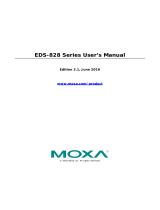
Table of Contents
1. Introduction to Layer 3 Switches ...................................................................................................... 1-1
The Layer 3 Switching Concept ............................................................................................................. 1-1
Static Routing and Dynamic Routing ..................................................................................................... 1-1
Static Routing ............................................................................................................................. 1-2
Dynamic Routing with RIP (Routing Information Protocol) ................................................................ 1-2
Dynamic Routing with OSPF (Open Shortest Path First) .................................................................... 1-2
2. IP Interface ...................................................................................................................................... 2-1
IP Interface Setting ............................................................................................................................. 2-1
3. Unicast Routing Protocols ................................................................................................................. 3-1
Static Routing .................................................................................................................................... 3-1
Static Routing Settings ................................................................................................................. 3-1
Dynamic Routing with Routing Information Protocol (RIP) ........................................................................ 3-2
RIP Settings ............................................................................................................................... 3-2
Dynamic Routing with Open Shortest Path First (OSPF) ........................................................................... 3-3
OSPF Global Settings ................................................................................................................... 3-3
OSPF Area Settings ..................................................................................................................... 3-4
OSPF Interface Settings ............................................................................................................... 3-5
OSPF Virtual Link Settings ............................................................................................................ 3-6
OSPF Area Aggregation Settings .................................................................................................... 3-7
OSPF Neighbor Table ................................................................................................................... 3-7
OSPF Database Table ................................................................................................................... 3-8
Routing Table ..................................................................................................................................... 3-8
4. Multicast Routing Protocols ............................................................................................................... 4-1
Local Route ........................................................................................................................................ 4-1
Multicast Local Route Settings ....................................................................................................... 4-1
Multicast ACL Settings ................................................................................................................. 4-2
Distance Vector Multicast Routing Protocol (DVMRP) ............................................................................... 4-3
DVMRP Settings .......................................................................................................................... 4-3
DVMRP Routing Table .................................................................................................................. 4-3
DVMRP Neighbor Table ................................................................................................................. 4-4
Protocol Independent Multicast Dense Mode (PIM-DM) ............................................................................ 4-4
PIM-DM Settings ......................................................................................................................... 4-4
PIM-DM Neighbor Table ................................................................................................................ 4-5
Protocol Independent Multicast Sparse Mode (PIM-SM) ............................................................................ 4-5
PIM-SM Settings.......................................................................................................................... 4-5
PIM-SM RP Settings ..................................................................................................................... 4-6
PIM-SM SSM Settings .................................................................................................................. 4-7
PIM-SM RP-Set Table ................................................................................................................... 4-8
PIM-SM Neighbor Table ................................................................................................................ 4-8
Multicast Routing Table ....................................................................................................................... 4-8
DVMRP Multicast Routing Table ..................................................................................................... 4-8
PIM-DM Multicast Routing Table .................................................................................................... 4-8
PIM-SM Multicast Routing Table .................................................................................................... 4-9
5. Gateway Redundancy ........................................................................................................................ 5-1
Virtual Router Redundancy Protocol (VRRP) ........................................................................................... 5-1
VRRP Settings ............................................................................................................................. 5-1
6. Tracking ............................................................................................................................................ 6-1




















